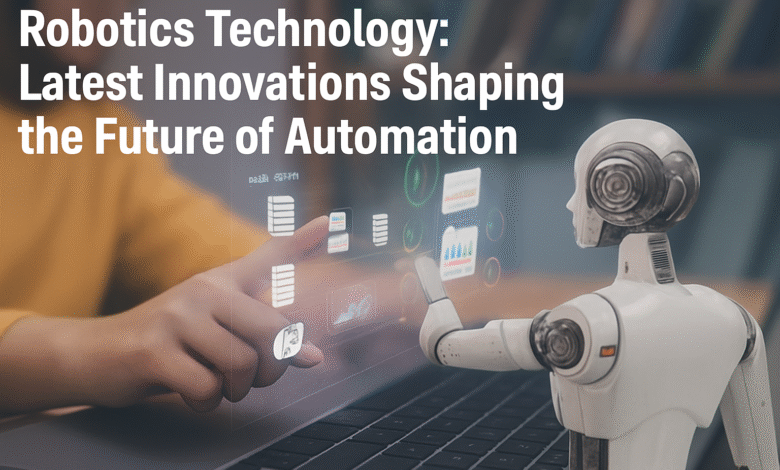Robotics Technology: Latest Innovations Shaping the Future of Automation
Robotics Technology: Latest Innovations Shaping the Future of Automation

One of the most booming spheres in the contemporary world is the use of robots. As artificial intelligence (AI), machine learning, and automation evolve, robots are no longer confined to science fiction: they become our present reality that sets the future of our world.
The robotics and their evolvement
Robotics is a development that has travelled a long way. Robots are highly advanced today, where they have cloud based legal system sensors, cameras, and intelligent algorithms; thus, enabling them to think, see and learn things around them.
Robotics Technology Use
1. Industrial Robots
Robots execute in the manufacturing industries; welding, painting, assembly and packaging. This enhances efficiency, brings down costs and produces uniform quality.
2. Medical Robots
Robotic surgical systems in health care enable physicians to conduct very precise procedures.
3. Military and security robots
The uses of robots are in bomb disposal, surveillance and border security. They are able to enter risky places where a human being becomes dangerous.
4. Spaceship – Deep Collision
Robotic rovers are explored by NASA in Mars and the deep oceans that could not be traveled by human beings are explored by underwater robots.
The Advantages of Robotic Technology
Efficiency/ Productivity: Robots have the ability to work 24 hourly without rest.
Safety: They are able to perform hazardous duties and lessen risks to humans.
Accuracy At a Microscopic Level: The robots are able to execute tasks with a lot of accuracy to the microscopic level.
The problems of Robotic Technology
Job Replacement: Automation can pose a threat to human labor, in certain industries.
Steep Prices: They are costly to develop and maintain robots.
Robotic Technology in Future
Robotics in the future has a bright future. We could, perhaps, encounter the use of robots which will support the elderly people, educate children, and even be companions. Smart drones and autonomous vehicles (self-driving cars) are only the first manifestation of a new era of robotics.
Robotic technology has different types and they are:
Service Robots: Repurposed in service work, the medical or educational field, etc. to carry out jobs like patient care, teaching and serving customers.
Autonomous Robots: Include the ability to travel freely and work in the world on their own without the necessity of a human to control it.
Humanoid Robots: Modeled in the form of Human beings, like shape and motion.
Mobile Robots: Able to move and traverse within various environments.
Collaborative Robots (Cobots): These have been designed to be used with human beings in space.
Space Robots: Applied in the exploration of space in navigating, and gathering data of the far planets and space objects.
Underwater Robots: These robots discover and do anything underwater, make explorations and research in the sea environment.
These are some of the trends that have been exercising a leading role in the robotics industry in 2025
Artificial Intelligence (AI) and Machine Learning (ML):
AI and ML are transforming the world of robotics and are enabling the ability to digest information in a more sophisticated manner, make decisions in real-time, and manage predictive maintenance. The AI-enabled robots can undertake multitasking like planning, pattern recognition, anticipation of a fault, etc.
Collaborative Robots (Cobots):
Cobots are collaborative robots that can co-exist and augment productivity and safety.
Humanoid Robots:
They are engineered to work with humans in a social environment and can act in a human-like dexterity.
Autonomous Mobile Robots (AMRs):
Such robots which are known as Autonomous Mobile Robots (AMRs) are gaining popularity in warehouses and logistics in the management of materials with efficiency. They are able to traverse intricate terrain through highly-sophisticated mapping and obstacle-avoidance computer technologies.
Digital Twin Technology:
It is possible to perform simulated testing, optimize performance and do predictive maintenance through this technology.
Sustainable Robotics:
Sustainability is an increased concern in the development of robots. The eco-friendly nature of materials.
Customization / modularity:
Customization of industries follows a preferred modular design to suit the needs.
Increased Sensor Technology
More advanced sensors make robots more apt to sense their surroundings and be more precise and detailed. Such sensors are very important in such applications as autonomous cars and healthcare.
Robotics in Service Industries
They are being applied in the areas of patient care, teaching and delivery.
Physical AI
Physical AI enables robots to be self- trained within the virtual world again and to act on the basis of experience and not programming.The systems of use in a traditional industrial setting and service robot use.
Conclusion
It opens the doors of innumerable opportunities of efficiency, security and bringing innovation. The trick is in adopting responsible use of robotics not in displacing it. That robots shall be able to influence.
FAQs
1. What is this technology of robotics?
Robotics technology is the field of acquiring technology that integrates computer science, engineering, and artificial intelligence that evolves the construction, design, and manufacture of robots.
2. Advantages of robotics technology?
Increment in efficiency, safety, quality of life and accuracy are the advantages to the robotics technology.
3. Which are the various robots?
Robots are of various kinds and examples of robots sub-groups include industrial robot, service robot, autonomous robot and social robot.
4. What is the use of robotics technology?
The applications of robotics technology are very broad and varied to include manufacturing, healthcare, transportation, education, and space exploration.
5. Where is robotics technology headed?
The scope and future of robotics technology is bright and robotics related trends and evolutions include artificial intelligence, autonomous technologies, collaboration between human beings and robotics and robotics in the service industry sectors. We can all utilize the power behind robotics technology and usage with the common knowledge we have and prepare a brighter future in front of us and the generations to follow.




